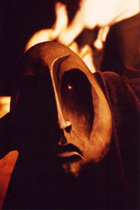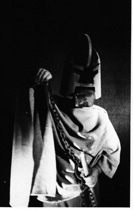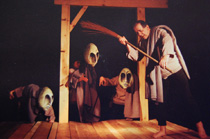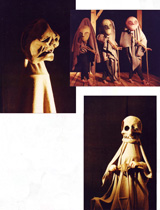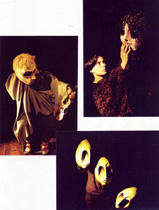 L'Histoire du soldat, 1988
L'Histoire du soldat, 1988
Musique : Igor Stravinsky
Concept, décor, masques et mise en scène : Felix Mirbt
Voici ci-dessous une sélection d'écrits de Felix Mirbt directement liés à la pièce L'Histoire du soldat ou en écho à son travail sur cette production, ainsi que des extraits de critiques datant de la création et d'une reprise en 1991.
MY SPACE – April 1996
In Munich in 1966
a Sicilian puppeteer about their noise level:
[like walking on their planks]
make noises, it indicates purpose and energy
stomp on the planks:
that is the space I walk, here is my stage!
So! There!
JE JOUE - JE CONSTRUIS
Un vieux marionnettiste ambulant s’est un jour assis près de moi. Je n’ai jamais oublié ce qu’il m’a dit : « Les fils de mes marionnettes sont noirs et épais parce que quand mes spectateurs ne voient pas les fils, ils se demandent comment je fais et ça les distrait de l’histoire ».
Les marionnettistes siciliens marchent derrière la scène sur des planches mobiles. Leurs marionnettes de près de 80 livres font la même chose sur la scène. J’ai demandé à ces marionnettistes ce qu’ils pensaient du bruit:
« Il faut faire du bruit, ça indique l’intention et l’énergie –
L’espace sur lequel tu marches, c’est ta scène
Piétine, martèle les planches ! »
Et voilà !
Je commence avec la marionnette à fils,
Trop petite
Fais-la plus grande
Les jambes m’embêtent
Coupe les jambes
Remplace les par des tissus
Je réalise que je n’ai pas besoin des mains non plus
Coupe les mains
Ma propre main est encore plus expressive
Quand je retourne à ma marionnette
Je prends visiblement le bras par l’extérieur avec ma main libre
Les fils invisibles sont distrayants
THE HORSEMEN
An anecdote?
For years I had wanted to stage the Histoire d'un soldat by Igor Stravinsky. When suddenly I was asked to do it (in the National Arts Centre in 1988), I found no way into it, the story didn’t seem very exciting anymore and... well, I concocted all sorts of obstacles and excuses.
I generally do not recall my dreams. But I remember the one I had that time, where I am at seashore, low tide, the water way out, it is night and I hear voices. The entire shore is sand but huge boulders sit all over the place and block the view. They sit sort of halfway in the ground, a sharp line of sand around their middle, the rocks therefore coming straight up as they do come out of the water in the lower Saguenay. It is night and I follow the voices around boulders. I finally see a flickering of fire mirrored on some rocks and when I turn the corner there are four guys sitting on the ground, lit by the glow of a log smoldering in the fire. They look at me and I do know them: the four horsemen of the apocalypse. I saw their weird faces clearly.
The work continued awkwardly. But a week later I had the exact same dream. I found this most surprising. I had a good look at their faces, because I knew I had to remember them.
They have become the main characters in my production.
They gave me new reference points
and I used their faces in their haunting quality.
They tell the Story of the Soldier.
They give their version of the Story
and their interpretation of the happenings.
And I did start to read C.G. Jung.
Felix Mirbt 1996
HISTOIRE DU SOLDAT (1988-96)
Igor Stravinsky with text by C. F. Ramuz
In my Story of a Soldier I use the `Four Horsemen of the Apocalypse', War, Hunger, Pestilence and Death, to tell the story, to contain the story, to comment on the story: The Soldier trades his violin to the Devil for all the riches in the world, still he gets to marry the Princess. Even though he believes he will be free through this marriage, a contract with the Devil never ends. And in the end even the Devil falls prey to the unpredictable games of the `Four Horsemen'.
THE CONCEPT:
Not wanting to work too literal I looked for strong, even startling images.
The Four Horsemen of the Apocalypse, four players, present the story on a gallows-like set of resonating planks. All masks and all props are laid out in a circle around it. The Four take down the effigies that are hanging from the gallows and tell the story, often their story - a play within a play, if you will.
The performers are using masks, which are more like full heads with blankets suspended underneath to suggest bodies. Sometimes we, the handlers, become their bodies.
We create images.
"The piece has a timeless look - it might have come from the Middle Ages, or from a troupe scrambling up the road behind Mother Courage's caravan. At the same time it displayed a clear debt to the theatre of the Thirties, specifically of bertholt brecht. Mirbt's puppetry had no strings or concealed artifice, and a fluid sense of its images. The players would sometimes exchange masks, or provide different bits of the same figure. The technique was at all times transparent, so that the stage illusion could be seen through to its bones. The magic of Mirbt's production was that the illusion endured nonetheless, putting us face to face with the primal mystery of theatre."
Robert Everett-Green, The Globe and Mail, 8.7.91
"Mirbt's view of the narrative takes the original C.F.Ramuz text to its limits and far beyond and adds vibrations that give the piece a relevance in an age when pacts with the devil have taken on meanings quite different from those understood either in the period of the First World War or the medieval plays on which the piece is based.
Conductor Eduardo Mata had worked with Felix Mirbt before and he was well aware that all concerned would be challenged by having this original artist take charge of the visual aspects of the production. Indeed the presentation by the actors with their masks and scraps of costume very nearly swamped the production as a whole. The visual dominated the presentation but, interestingly, Stravinsky's score has never seemed more relevant or more fascinating. "
Jacob Siskind, The Ottawa Citizen, 19.5.1988
EXTRAIT DE JOURNAL
My images do not necessarily follow the story or the music. They have a life of their own, can become a counterpoint to the music and/or the spoken text. The characters of this story, the Soldier, the Devil and the Princess, are placed into these images. It is this placement that draws us closer to the source of the myth out of which they exist. It is the myth in the Story of a Soldier that makes it contemporary and the premise that "Once you make a contract with the devil, you're stuck with it", that lets us draw current parallels.
(In his Story of a Soldier), Stravinsky intended a separation of emotion from action. Intrigued I continued the process by separating "Voice" from "Movement". This separating allows us to look more clearly at each piece or detail: at it's visual, textural and textual identity and thus makes the work as a whole stronger. Providing these pieces (of my choice) I allow the audience (with their perception) to reassemble, to (re)create the story in their own image.
La raison qui m’a emmené aux marionnettes n’est pas encore claire pour moi. J’ai toujours pensé que ça avait à voir avec leur mécanique fascinante.
Je tire une ficelle en haut et quelque chose bouge en bas. J’imagine que c’est en partie vrai.
Mais je soupçonne aussi que c’est du au sentiment sécurisant de pouvoir contrôler l’image.
Je cherche des motifs visuels qui bougent avec la musique ; des images animées, qui n’ont pas besoin de se modeler sur l’histoire ni sur la partition, dotées de leur propre existence et pouvant faire contrepoint à la musique et au texte. Je m’intéresse vivement au processus qui consiste à séparer La voix et Le texte, et quelquefois le mouvement et l’image. Car ainsi, chaque fragment peut-être observé et examiné en détail, sous l’angle de l’aspect visuel, de la texture, du contenu textuel – ce qui enrichit d’autant l’ensemble. En présentant des fragments, j’invite donc les spectateurs à rassembler ceux-ci pour (re)créer l’histoire dans une perspective qui leur est propre.
